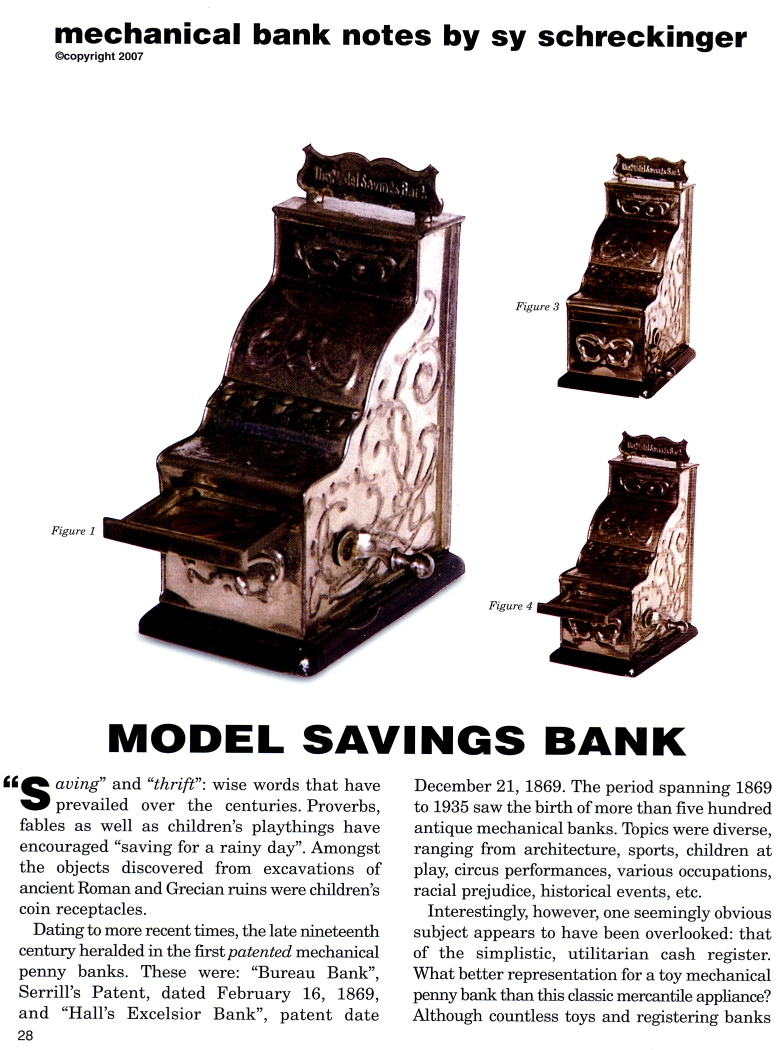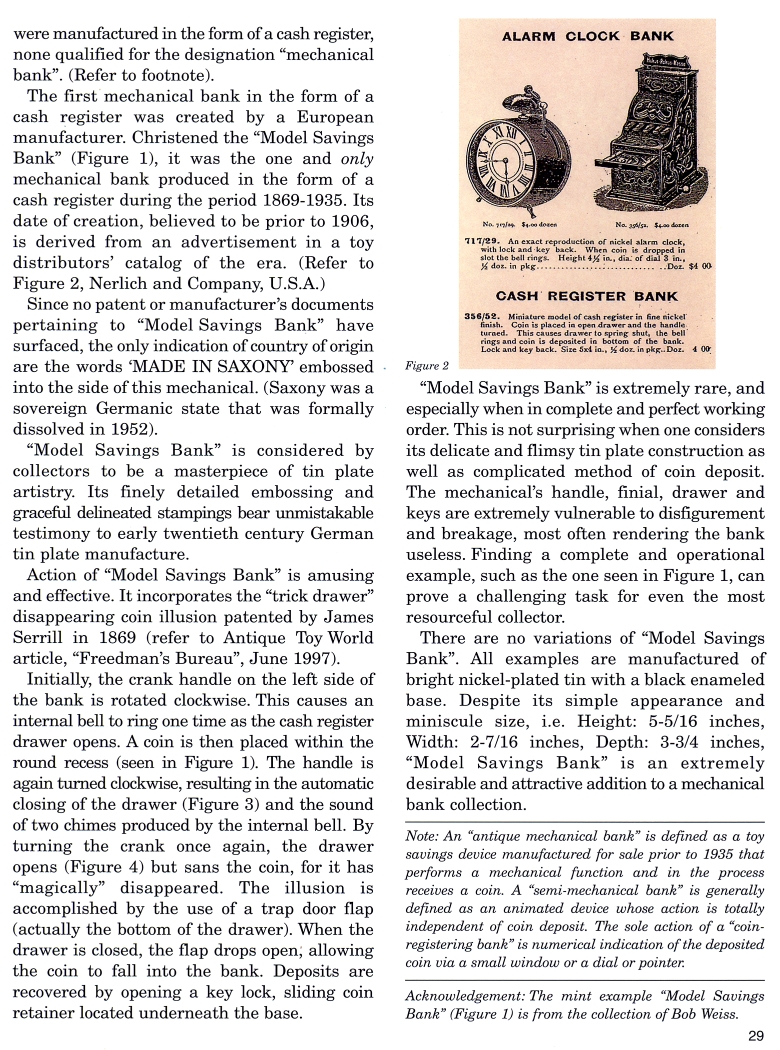|
Model Savings Bank
by Sy Schreckinger – ANTIQUE TOY WORLD Magazine – February, 2007
"Saving" and "thrift": wise words that have
prevailed over the centuries. Proverbs, fables as well as children's
playthings have encouraged "saving for a rainy day". Amongst the objects
discovered from excavations of ancient Roman and Grecian ruins were
children's coin receptacles.
Dating to more recent times, the late nineteenth century heralded in
the first patented mechanical penny banks. These were: "Bureau Bank",
Serrill's Patent, dated February 16, 1869, and "Hall's Excelsior Bank",
patent date December 21, 1869. The period spanning 1869 to 1935
saw the birth of more than five hundred antique mechanical banks. Topics
were diverse, ranging from architecture, sports, children at play, circus
performances, various occupations, racial prejudice, historical events,
etc.
Interestingly, however, one seemingly obvious subject appears to have
been overlooked: that of the simplistic, utilitarian cash register. What
better representation for a toy mechanical penny bank than this classic
mercantile appliance? Although countless toys and registering banks were
manufactured in the form of a cash register, none qualified for the
designation "mechanical bank". (Refer to footnote).
The first mechanical bank in the form of a cash register was created
by a European manufacturer. Christened the "Model Savings Bank" (Figure
1), it was the one and only mechanical bank produced in the form of a cash
register during the period 1869-1935. Its date of creation, believed to be
prior to 1906, is derived from an advertisement in a toy distributors'
catalog of the era. (Refer to Figure 2, Nerlich and Company, U.S.A.)
Since no patent or manufacturer's documents pertaining to "Model
Savings Bank" have surfaced, the only indication of country of origin are
the words 'MADE IN SAXONY' embossed into the side of this mechanical.
(Saxony was a sovereign Germanic state that was formally dissolved in
1952).
"Model Savings Bank" is considered by collectors to be a masterpiece
of tin plate artistry. Its finely detailed embossing and graceful
delineated stampings bear unmistakable testimony to early twentieth
century German tin plate manufacture.
Action of "Model Savings Bank" is amusing and
effective. It incorporates the "trick drawer" disappearing coin illusion
patented by James Serrill in 1869 (refer to Antique Toy World article,
"Freedman's Bureau",
June 1997).
Initially, the crank handle on the left side of the bank is rotated
clockwise. This causes an internal bell to ring one time as the cash
register drawer opens. A coin is then placed within the round recess (seen
in Figure 1). The handle is again turned clockwise, resulting in the
automatic closing of the drawer (Figure 3) and the sound of two chimes
produced by the internal bell. By turning the crank once again, the drawer
opens (Figure 4) but sans the coin, for it has "magically" disappeared.
The illusion is accomplished by the use of a trap door flap (actually the
bottom of the drawer). When the drawer is closed, the flap drops open,
allowing the coin to fall into the bank. Deposits are recovered by opening
a key lock, sliding coin retainer located underneath the base.
"Model Savings Bank" is extremely rare, and especially when in
complete and perfect working order. This is not surprising when one
considers its delicate and flimsy tin plate construction as well as
complicated method of coin deposit. The mechanical's handle, finial,
drawer and keys are extremely vulnerable to disfigurement and breakage,
most often rendering the bank useless. Finding a complete and operational
example, such as the one seen in Figure 1, can prove a challenging task
for even the most resourceful collector.
There are no variations of "Model Savings Bank". All examples are
manufactured of bright nickel-plated tin with a black enameled base.
Despite its simple appearance and miniscule size, i.e. Height: 5-5/16
inches, Width: 2-7/16 inches, Depth: 3-3/4 inches, "Model Savings Bank" is
an extremely desirable and attractive addition to a mechanical bank
collection.
Note: An "antique mechanical bank" is defined as a toy savings device
manufactured for sale prior to 1935 that performs a mechanical function
and in the process receives a coin. A "semi-mechanical bank" is generally
defined as an animated device whose action is totally independent of coin
deposit. The sole action of a "coin-registering bank" is numerical
indication of the deposited coin via a small window or a dial or pointer.
Acknowledgement: The mint example "Model Savings Bank" (Figure 1) is
from the collection of Bob Weiss.
|


